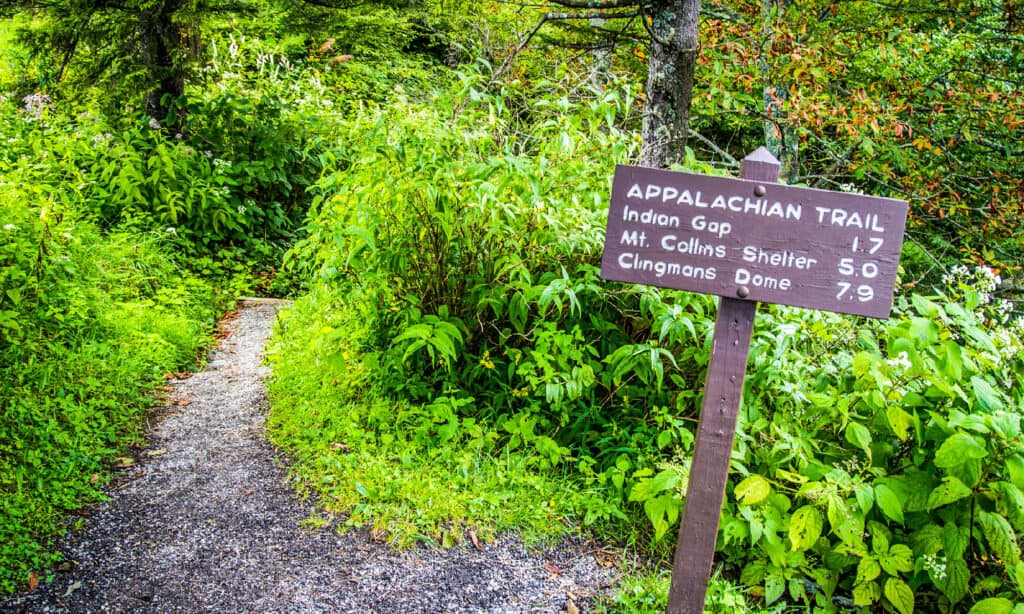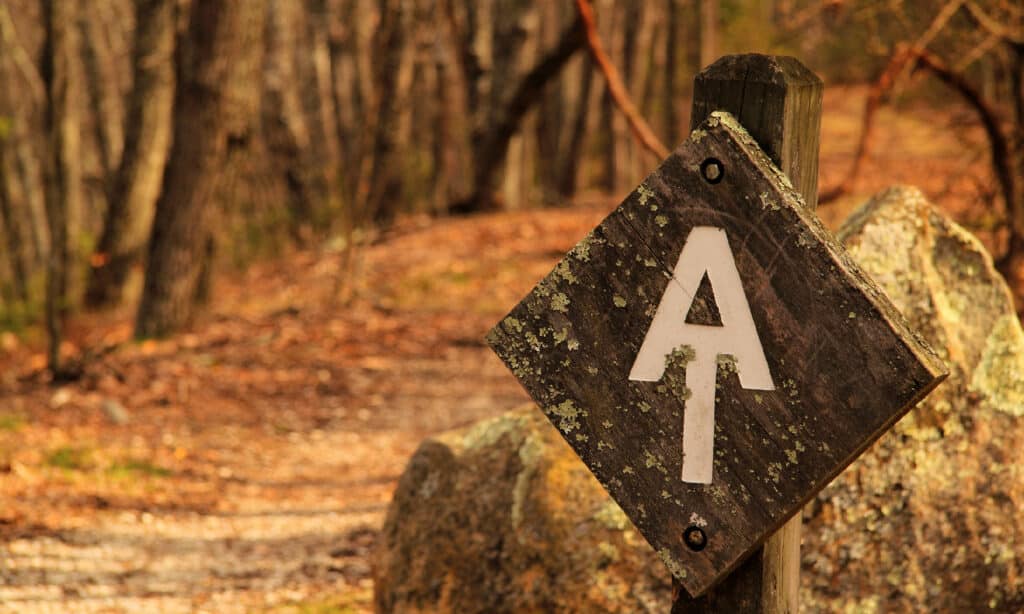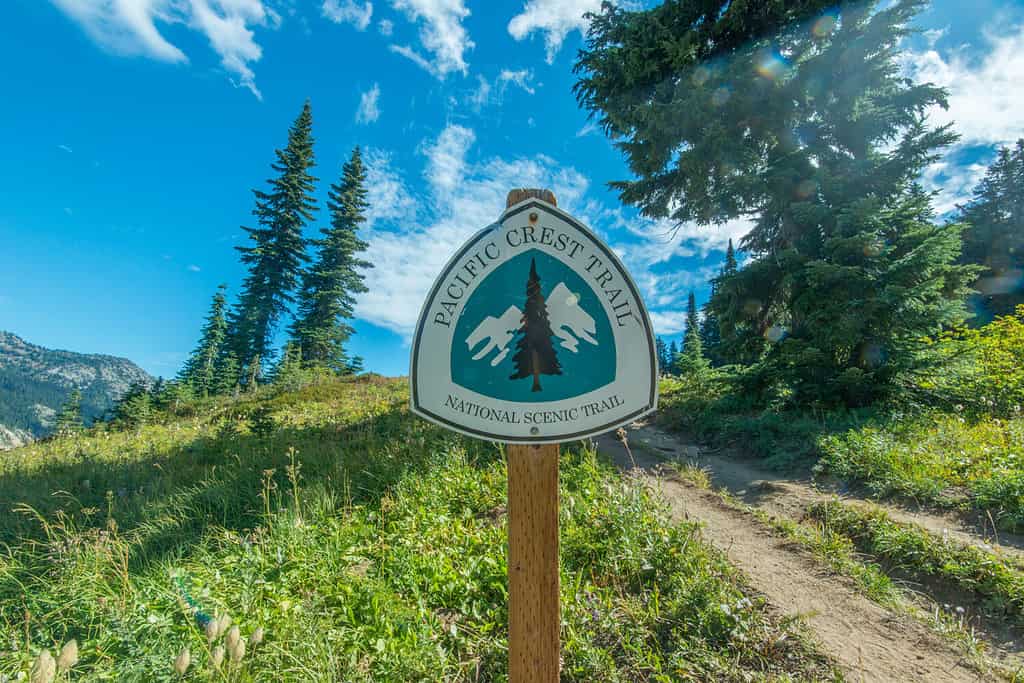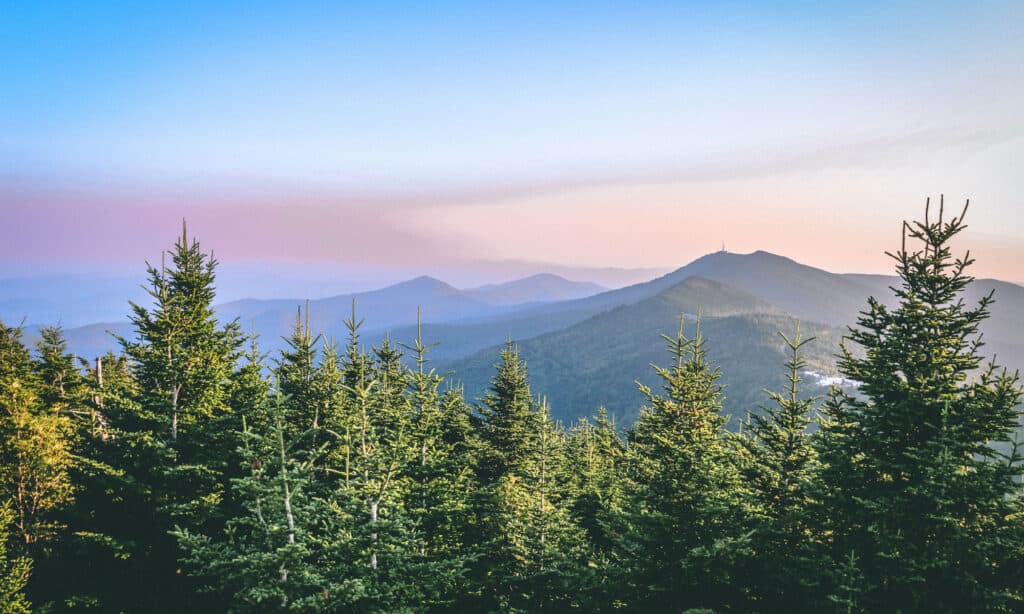Completing a long-distance hike is a test of resolve. It’s the ultimate opportunity to explore your limits as you journey into the wilderness.
Whether you’re eyeing the legendary Appalachian Trail (AT) or the breathtaking Pacific Crest Trail (PCT), both choices demand unstoppable resilience. Along with strength and gear, you also have to have the right mindset to make it to the finish.
Let your adventure begin here as you choose which trail is right for you. Should you embark on the famously rocky Appalachian trail? Or would you be better suited for the paths of the Pacific Crest Trail? Follow along to find out which national scenic trail is right for you.
Key Points: Appalachian Trail vs. Pacific Crest Trail
- The Appalachian Trail (AT) is known for its social culture and many shelters, while the Pacific Crest Trail (PCT) has fewer hostels and social spots.
- On the PCT, your gear changes with the terrain, while on the AT, your gear depends on the season.
- The AT takes 5-7 months to finish.
- The PCT takes 5 months to complete.
- The PCT may be seen as harder because of high elevations.
- AT has more shelters, and the PCT has more tent camping.
- The AT has more water sources.
- The PCT can be pricier because of higher food costs and the need for mail deliveries in remote areas.
- Both the Pacific Crest Trail and the Appalachian Trail are famous long-distance hikes that qualify as national scenic trails.
Which Trail Is the Best for First Timers?
Both the Appalachian and Pacific Crest Trails are great choices for first-timers. Your decision depends on the type of challenges you prefer.
If you’re looking for a less physically demanding hike, many hikers suggest the Pacific Crest Trail (PCT). The trails on the PCT are generally less steep and rocky compared to those on the Appalachian Trail (AT). However, it’s important to note that choosing the PCT is still a very challenging journey. And it’s one where you’ll likely have a more solitary experience in the wilderness. There are fewer established stations to welcome hikers on the PCT.
On the other hand, the AT offers a more social experience. You can take side trips into nearby towns, stay in hiker-friendly hostels, and engage in activities like signing guestbooks, which fosters a sense of a shared adventure with other hikers.
Finally, the PCT is a good option for beginners due to its dry climate, providing pleasant weather with fewer rainy days. However, again, it’s worth saying that there’s a stronger sense of solitude on the PCT. Even though the AT is notoriously rainy, hikers have plenty of opportunities to refuel and rest in town.
Appalachian Trail Overview

The Appalachian Trail travels through 14 different states.
©iStock.com/ehrlif
- The AT travels through six national parks and eight national forests.
- It takes about 5,000,000 steps to hike the entire A.T.
- The AT includes over 500,000 feet of vertical gain.
- Popular trail where you can connect with others and build a shared adventure.
The AT trail travels through 14 different states: Georgia, North Carolina, Tennessee, Virginia, West Virginia, Maryland, Pennsylvania, New Jersey, New York, Connecticut, Massachusetts, Vermont, New Hampshire, and Maine.
Pacific Crest Trail Overview

The Pacific Crest Trail travels through three states.
©iStock.com/RobertCrum
- PCT is longer (2,653 miles) with a higher elevation change of 489,418 feet.
- Trail regions include Southern California, Central California, Oregon, and Washington.
- While the AT is more social, the PCT offers solitude.
The PCT travels through three states; California, Oregon, and Washington. Here hikers have a chance to follow the high parts of the Sierra and Cascade mountain ranges, designated as a national scenic trail in 1968.
Which Trail Is More Difficult?
The AT is generally seen as tougher because it’s full of rugged terrain with lots of rocks and roots, making hiking slow. It’s 2,190 miles long and usually takes 5 to 7 months to finish. Plus, many of the trails on the AT experience frequent changes in elevation.
On the other hand, the PCT is longer at 2,650 miles long, but the paths are smoother. Rather than dealing with rocks and steep inclines, hikers have to prepare themselves for hiking at a higher elevation, and sometimes in scorching hot weather. Plus, the limited availability of water sources emphasizes the need for careful planning.
Elevation Differences
The AT covers 2,190 miles with an elevation change of 464,500 feet. Whereas, the PCT is 2,650 miles with an elevation change of 489,418 feet.
Defining the Hike: Appalachian Trail vs. Pacific Crest Trail
What are the other differences between the Appalachian Trail (AT) and the Pacific Crest Trail (PCT)? The way each hike defines the term, “thru-hike”.
On the AT, the criteria for a thru-hike is more strict. To qualify as finished, this trail requires hikers to complete the entire trail from start to finish.
What’s a Thru Hike?
A thru-hike is short for “through-hike.” It’s a challenging long-distance hiking journey that includes traveling a long-distance route from one end to the other. It’s normal for these hikes to cover hundreds or even thousands of miles.
National Scenic Trail
The Pacific Crest Trail and the Appalachian Trail are both national scenic trails, carefully maintained to let people enjoy their natural beauty and protect them for the future. These trails were designated in 1968 because of their exceptional beauty and ability to offer a great outdoor experience. Plus, these trails offer opportunities to learn about other cultures, and pieces of history. Other trails that have earned the national scenic title include the Florida National Scenic Trail and the Natchez Trace Scenic Trail.
Trail Time Estimates

Prepare for long days of trekking, hauling around heavy packs, and handling various terrains.
©adriaticfoto/Shutterstock.com
A typical AT thru-hiker typically takes 5 to 7 months to complete the trail, whereas the PCT generally takes closer to 5 months.
Success Rates
Since both trails are highly popular, thousands of hikers attempt thru-hikes each year, but only a small fraction successfully finish the journey. Physical limitations, bad weather conditions, and logistical challenges can cause hikers to call it quits.
Plus, both trails demand you to be in top-notch physical condition. Thru-hikers should be ready for long days of trekking, hauling around heavy packs, and handling various terrains. And don’t forget about the unpredictable weather! Rain, snow, lightning; there’s a lot hikers have to contend with.
Finally, the start time is another factor to consider when choosing which trail to hike first. Your experience and ability to handle intense weather will influence when you should depart.
Best Time to Start the Appalachian Trail

Many hikers choose to depart on the Appalachian trail at the end of March or first half of April.
©iStock.com/Wilsilver77
For the AT, most thru-hikers choose to kick off their journeys in March or the first half of April. A popular starting point is Springer Mountain in Georgia.
Northbound (NOBO) thru-hikers face a specific time constraint: they must reach Katahdin, the trail’s northern terminus before Baxter State Park closes access to the summit in mid-October. This limitation makes it necessary for NOBO hikers to start their journeys in spring and maintain a steady pace.
Southbound hikers (SOBO) have a shorter departure window. They should begin a thru-hike are June or early July, but beware. Starting earlier means dealing with challenging conditions in Maine, including high water, black flies, mud, and fallen trees from the winter.
How to Handle Maine’s Black Flies
Maine is known for its pesky “biting fly” season, particularly the bothersome black flies. The blackflies take over the skies from Mother’s Day to Father’s Day. So, if you’re planning on leaving a little early for a SOBO hike, get ready.
These little insects are usually black or gray and have short legs and tiny antennae. They belong to the Simuliidae family, and within this family, there are four groups of species that like to bite people.
The good news is you can outrun black flies, just keep up the pace. Unlike swarms of mosquitoes, you can usually get away from them if you keep moving.
Best Time to Start the Pacific Crest Trail

Most northbound hikers start the Pacific Crest Trail in mid-April through early May
©Modern Meta Photography/Shutterstock.com
The best time to start the PCT varies depending on whether you’re hiking NOBO or SOBO (northbound or southbound). Most NOBO hikers start in mid-April through early May, while SOBO hikers typically begin in late June through early July.
Getting the timing right for your departure is everything. If you kick off your journey too early, you’ll have to deal with dangerous stream crossings and snowy conditions, particularly in the Sierra Nevada and Washington sections.
Starting late is also problematic. In Southern California, extreme heat becomes a major concern, and those who start later might find it difficult to complete the entire trail before winter weather sets in.
Snowfall Considerations

Snowfall is a major consideration when choosing what time to start either hike.
©Mariia Tagirova/Shutterstock.com
You can hike in the snow, but it’s not an experience everyone’s into. Snow makes a hiking trip more like a mountaineering trip. You’ll need the strength, expertise, and gear to be successful. Plus, the snow is going to slow you down quite a bit. Which means planning a longer hiking window than the typical 5-7 months.
Snowiest Appalachian Trail Times
On the AT, you can run into snow almost anywhere until early April, and sometimes even later! Up in the northern Appalachians, snow can show up at any time, and in remote areas, it might stick around until June.
Some places like the southern Appalachians, Vermont, New Hampshire, and Maine can still feel like winter in late spring and early fall. And locations with an elevation above 5,000 feet, can receive deep snowfall. We’re talking close to 100 inches of snow each year.
To avoid any snowy surprises, keep an eye on things with websites like the National Weather Service National Snowfall Analysis.
Snowiest Pacific Crest Trail Times
When it comes to the PCT, most people prefer to start their journey after the snow has melted. In the Western U.S. mountains, you can usually find snow-free conditions from early July to September. However, it’s important to keep in mind that there might still be snow in higher areas, especially in shady and north-facing spots during the early season. So, if you’re thinking about backpacking in the Western U.S. mountains in May or June, you might run into snowy trails at higher altitudes.
What Are the People Like for Each Trail?
If it’s your first time taking a trip like this, you might feel more at home on the AT. Here, you’ll find a lot of like-minded individuals. Many people hiking the AT are completely new to long-distance hiking. Whereas, a lot of the hikers on the PCT have already done the AT.
Hikers on the AT also enjoy hiker-friendly shelters along the route, encouraging interaction and shared experiences. Furthermore, towns near the AT are closely linked to the trail, with many offering hiker-specific amenities like hostels, creating a welcoming atmosphere for your adventure.
AT vs. PT: Gear Requirments
The equipment required for the PCT is determined by the specific segment you’re hiking. Conditions range from scorching desert heat to snowy sections in the Sierra. PCT hikers are generally recommended to keep their 20-degree sleeping bags or quilts with them for the entire trail.
On the other hand, the gear requirements for the AT depend on the season. In the early sections, you’ll need cold-weather gear. However, since the AT tends to be more humid, which means you can use lighter sleeping gear during the summer.
As for where you’ll sleep, the AT provides more than 200 shelters, in addition to allowing tent camping. In contrast, the PCT lacks shelters but provides numerous opportunities for tent camping.
Bring Paper Maps
One of the most important tools for any hiker is a reliable set of maps. These trails are a constantly changing wilderness, and quality maps are essential for a safe and successful journey. Thankfully, there are a lot of resources for getting quality paper maps that provide information about the trail, water sources, and campsite locations.
What About Resupply?
Both trails provide opportunities to resupply in nearby towns. But because of its popularity, resupplying on the AT is typically easier and more straightforward. The AT offers more frequent and closer access to towns for resupply and rest. Whereas, PCT towns are farther apart, and hikers might need to hitchhike long distances.
Mail Drops
AT hikers can usually finish the trail without needing to send mail drops, which are packages of supplies sent to specific locations along the trail. But the same can’t be said for the PCT, which requires multiple mail drops. It’s a cost-effective option that means sending supplies to specific points ahead of time.
Water Sources
Don’t forget about your water sources. The AT has more frequent water sources and stream crossings, reducing the need for carrying water. While the PCT can involve longer water carries due to scarce sources.
More About the Appalachian Mountains

The highest peak in the Appalachian Mountains is Mt. Mitchell in North Carolina.
©iStock.com/Frederik Flagstad
The Appalachian Mountains are the oldest of the three major mountain ranges in the United States, dating back about 480 million years. They cover a large part of the eastern U.S., from Alabama and Georgia to Maine. The highest peak is Mt. Mitchell in North Carolina, which reaches 6,684 feet above sea level.
Along with the Rocky Mountains and Sierra Nevada, the Appalachian Mountains are one of the most impressive ranges around. These peaks have undergone all sorts of changes over the years. First, they were eroded into a plain during the Mesozoic Era. Then they came back 65 million years ago during the Cenozoic Era due to volcanoes and tectonic activity.
Wildlife
Black bears are most commonly encountered in the Great Smoky Mountains, Shenandoah National Park, and New Jersey. There’s also coyotes, deer, hogs, and all sorts of birds that live along the trail.
Here’s some of the wildlife you may encounter along the AT trail:
- Coyotes
- Bears
- Mice
- Snakes
- Spiders
- Stinging Insects
- Mosquitoes
- Hogs
Mice are a common presence along the Appalachian Trail, especially in trail shelters. The most frequently encountered species in these areas are the white-footed mouse and the deer mouse. If you happen to spot a larger rodent, it’s likely a wood rat, although they are not as common.
Why are there so many mice around? Hikers unintentionally invite these rodents by leaving behind food crumbs. To ensure your safety store your food in containers designed to keep rodents out, such as bear canisters. Also, before using shelters that may have been inhabited by mice, take 30 minutes to air them out. And, when cleaning these structures, avoid sweeping up droppings or nesting materials. Doing so could stir up dust.
Plants
The Appalachian Mountains see a lot of rainy days, with the annual rainfall resting right between 35 and 51 inches. All of that rain supports numerous plants and animals, making this area all the more exciting. Plants in the mountains include laurel, flame azalea, witch hazel, and spicebush. As for the forests of the Appalachians, there are deciduous hardwood trees like oaks, maples, birch, beech, ash, and tulip poplars.
Depending on when you’re hiking, there’s also a ton of vibrant wildflowers. Spring is the peak of wildflower season in the eastern forests. You can expect to see colorful blooms such as fire pink, Dutchman’s breeches, bloodroot, and trillium.
Why Do They Call it the Pacific Crest Trail?

The Pacific Crest Trail has five different regions, with three of them in California.
©Anne08/iStock via Getty Images
The PCT got its name because it mostly follows the high parts of the Sierra and Cascade mountain ranges in California, Oregon, and Washington.
The PCT is divided into several regions:
- Southern California
- Central California
- Northern California
- Oregon
- Washington
Southern California
The Southern California part of the PCT is 648 miles long, beginning near the Mexican border in Campo. This region takes you through various landscapes like the Laguna Mountains, Anza-Borrego Desert State Park, and the San Jacinto Mountains. This trail passes two mountain ranges, offering beautiful views of the Los Angeles Basin and Mojave Desert. It ends at Walker Pass, known for its active wildlife.
Central California
The 505-mile Central California section of the PCT starts at Walker Pass with an elevation of 5,246 feet. This region passes through remote landscapes, crossing rivers and ascending mountain passes, including the highest point on the trail, Forester Pass with an elevation of 13,180 feet. The Central California section also joins the John Muir Trail in Sequoia National Park and continues along the Sierra crest to Interstate 80. Expect to see chickadees and red-tailed hawks flying around.
Oldest Person to Complete Each Trail
The oldest person to hike the Appalachian trail was an 83-year-old man named Nimblewill Nomad. M.J. “Sunny” Eberhart, widely known as Nimblewill Nomad, defied the odds by becoming the oldest hiker at 83 to conquer the Appalachian Trail. His incredible journey took over 25 years and was marked by numerous falls on slippery rocks. Another thing that made this hiker stand out was the way he tackled the trail out of order. By dividing the trail into sections he was able to avoid some of the worst weather conditions.
The previous record holder, Dale “Greybeard” Sanders, was 82 years old in 2017. Instead of feeling sad about losing the record, Dale was happy about Eberhart claiming the title. He saw this achievement as another inspiring story that can uplift people of all ages. Who knows how old the next hiker will be to break this record? Maybe they’ll even be in their 90s!
Oldest Person to Hike the Pacific Crest Trail
The oldest man to complete the PCT is Al Learned, at the age of 81 and 58 days in 2018. Also known by his trial name “Al”, he achieved this amazing accomplishment over the course of 13 years. The journey began in 2005 when AI was 68 years old.
The photo featured at the top of this post is © Gajus/iStock via Getty Images
Thank you for reading! Have some feedback for us? Contact the AZ Animals editorial team.







